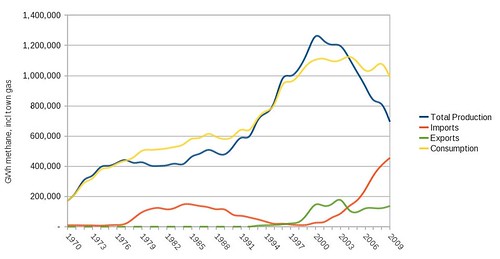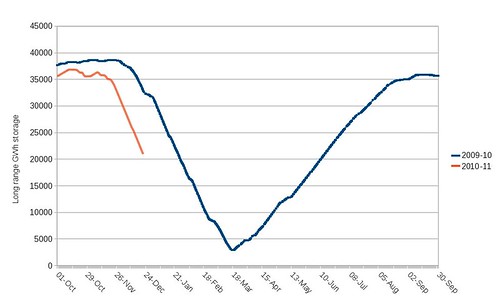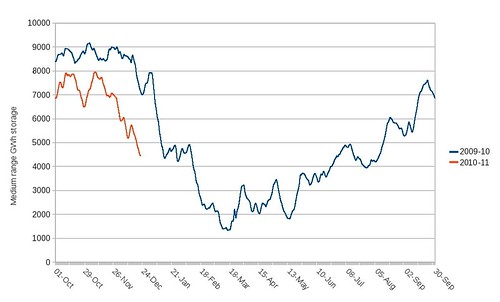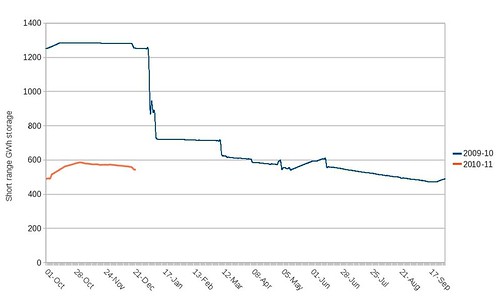We won't "run out", but we could well have shortages. Here's why...
First, it's important to understand the overall picture. The UK had been a gas exporter from the mid-nineties until a few years ago, but now production from the North Sea has been plummeting for over five years, we're a significant importer. The graph below illustrates this - when the blue line is above the yellow, we were a net exporter, when it is below, we were a net importer. Click it for a larger version.

Gas supply in the UK comes from several sources at present:
Each of these sources of gas has key strengths and weaknesses, such as:
Current state of UK gas storage
You can view the current amount of gas in storage, and various other bits of technical info, on a website run by the National Grid. Click the help link on that page for more info.
However, what's more interesting is to be able to look at the levels of gas storage this winter so far, and compare them to a year ago. It's quite a bit of work to get the data for this and make some charts, so I've done it for you. The following charts show long, medium and short range storage levels from October through to September, with the red line representing this winter, and the blue line winter 2009-10. Again, click for larger versions.



There are several things to note from these graphs:
At present (late December 2010), gas storage is about 52% full, while a year ago it was about 85% full. If the remainder of the 2010-11 winter remains cold, or even just colder than average, then gas storage could well be completely depleted before winter ends.
If withdrawals from storage continue at the average rate for December 2010 so far, there are only 45 days of stocks remaining.
So what will happen when stocks get low?
Supply to domestic customers will be guaranteed if at all possible, as the industry and government can not afford to have many thousands of people without heating in the winter, not to mention the technical difficulties with shutting off large areas of the gas network. The procedure that is followed is detailed on government and National Grid websites, such as this presentation.
The stages are:
Let's hope it doesn't come to that. But be aware that the risk grows as long as the weather stays cold, and that any accident or malfunction in gas supplies could tip the system over the edge quite quickly, especially later in the winter.
Electricity
One final point - about 40% of our electricity in the UK is generated by burning gas, and these power stations could have their supply cut in an emergency. While other sources, such as coal and oil fired stations would be brought to maximum output, there could still be a shortfall, so a gas supply emergency implies an electricity shortage as well.
Links
Here are links to where I got the data from for the charts above, and where you can read more:
I'll probably do an update in a few weeks, when the effect of the weather has become clearer. In the meantime, consider what you might do in a gas supply emergency, and make appropriate preparations.
Mike
This blog aims to provide the latest news and comment relating to Peak Oil, and related issues such as supply of other fossil fuels, renewable energy, sustainability and finance. Global issues are covered from a UK perspective.
Friday, 24 December 2010
Will the UK run out of gas in February 2011?
Sunday, 19 December 2010
UK's first Gas Balancing Alert for 2010/11
I just blogged on this for the Ashden Awards. I've been expecting an alert from the National Grid for some weeks, and now it's here. I expect some more alerts this winter, and if it stays cold we could be in for some real problems...
Mike
Subscribe to:
Comments (Atom)